Sergeant-at-Arms Office
State Capitol, Room 3030
Sacramento, CA 95814
Phone: (916) 651-4184
Fax: (916) 327-9222

You are here
California History
1849
When Thomas J. Austin served as the Sergeant-at-Arms for the first meeting of the California State Senate in December 1849 his primary duties included maintaining decorum, bringing absent members to the chambers and providing security for the members of the Senate.
1853
The State Legislature authorized a law enforcement body called California State Rangers in order to capture a notorious gang leader, Joaquin Murrieta. Although the Rangers were disbanded after the capture they were the forefathers of the State Police.
1860
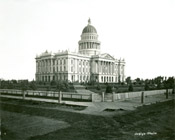 From the 1860's to the 1880's Capitol Park, which was bordered by L Street, N Street, 10th Street and 13th Street, was surrounded by a low wood picket fence.
From the 1860's to the 1880's Capitol Park, which was bordered by L Street, N Street, 10th Street and 13th Street, was surrounded by a low wood picket fence.
1884
In 1884 a granite and masonry fence was constructed to replace the wood fence at the front of Capitol Park from 11th and N Street around 10th Street to 11th and L Street and bollards (granite posts) were placed around the remaining Capitol grounds, from 11th and L Street around 13th Street to 11th and N Street.
1887
On March 15, the California State Legislature authorized a law enforcement body of two Rangers, which would later become the California State Police to protect the State Capitol and grounds. Over the years it grew to a force of 12 officers.
1911
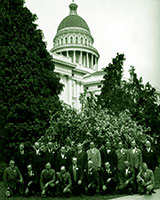 The Legislature approved more positions, uniforms and defined the "law enforcement body" giving it the official name "California State Capitol Police." As the department and its duties expanded, the word "Capitol" was dropped from the agencies name.
The Legislature approved more positions, uniforms and defined the "law enforcement body" giving it the official name "California State Capitol Police." As the department and its duties expanded, the word "Capitol" was dropped from the agencies name.
1940
The fence and bollards were removed from Capitol Park as part of the Capitol Annex construction and site modifications and were not replaced.
1967
The legislature was in session, debating a gun control bill, when two dozen armed members of the Black Panthers marched into the Assembly chamber. Then Assembly Chief Sergeant-at-Arms ordered the protesters out while terrified legislators hid behind their desks. The protesters, whose guns where not loaded, complied by leaving the building. Although they were not breaking any laws at the time, the next day legislation was introduced to make it illegal to bring weapons or firearms into the State Capitol.
1968
The Legislature and the Governor approved legislation authorizing the State Police to provide full-time protection to all Constitutional Officers.
1975
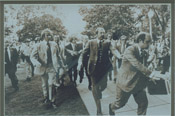 Attempted assassination of President Ford by Lynette "Squeaky" Fromme (a devotee of Charles Manson) on the east side of Capitol Park while he walked toward the Capitol to deliver a speech to a Joint Session of the Legislature.
Attempted assassination of President Ford by Lynette "Squeaky" Fromme (a devotee of Charles Manson) on the east side of Capitol Park while he walked toward the Capitol to deliver a speech to a Joint Session of the Legislature.
1978
A shooting occurred in the Capitol basement when an individual entered in his automobile with a rifle on the seat demanding to see the Governor. The shooting occurred when the person attempted to run over the officer interviewing him.
1980
A hostage was taken in the temporary bill room constructed outside the North Annex entrance door. It was resolved with injuries sustained to a police officer and the perpetrator.
1980
Explosive device delivered through public doors to the Governors mail room on the first floor of the State Capitol. Trained staff recognized what it was and the device was disarmed.
1981
 The Senate's Chief Sergeant-at-Arms began to re-emphasize security of the Senate and Senators as the primary duty of the Sergeant-at-Arms Office and took a list of non-security related tasks to the Senate Rules Committee. The Committee then gave the Senate Chief Sergeant-at-Arms the authority to refuse any chore that is not "legitimate legislative business".
The Senate's Chief Sergeant-at-Arms began to re-emphasize security of the Senate and Senators as the primary duty of the Sergeant-at-Arms Office and took a list of non-security related tasks to the Senate Rules Committee. The Committee then gave the Senate Chief Sergeant-at-Arms the authority to refuse any chore that is not "legitimate legislative business".
1983
The California Highway Patrol Security Kiosks and the anti-terrorist vehicle barriers were added to the Capitol driveways to prevent unwanted vehicles from entering the building. Additionally, bullet-proof glass was installed in the Governor's office windows and shatter resistant film was applied to the Capitol building's first floor, Senate and Assembly chamber windows.
1984
Firebombing of the west wing of the State Capitol. A five gallon gas can was thrown in the window of the Governor's office along with a lit road flare, resulting in fire and water damage.
1987
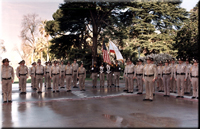 The State Police celebrated 100 years of service, making it the oldest State Law Enforcement Agency in California.
The State Police celebrated 100 years of service, making it the oldest State Law Enforcement Agency in California.
1992
Senate Sergeants are instrumental in the development of the Capitol Building Emergency Plan (CBEP) which outlines, in detail, the responsibilities in the event of an emergency, disaster or an incident for the safety of the Capitol's elected officials, employees and visitors. (Congress has used this as a model for its own plan).
1995
On July 12, 1995, 271 uniformed officers of the State Police became part of the 5,713 sworn officers of the California Highway Patrol.
2001
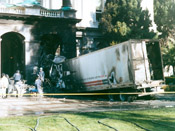 On a quiet January evening a truck driver, with a history of domestic violence arrests, drove an 18 wheel truck into the south side of the State Capitol resulting in his own death and 19 million dollars of damage to the State Capitol building.
On a quiet January evening a truck driver, with a history of domestic violence arrests, drove an 18 wheel truck into the south side of the State Capitol resulting in his own death and 19 million dollars of damage to the State Capitol building.
2002
Implementation of the Capitol Security Technician (CSTs), security cameras and metal detectors. CSTs provide security screening for individuals entering the Capitol Building.
2006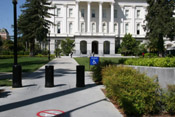
A low fence and bollards were installed around the Capitol building. In some locations, the bollards are mechanically retractable and can be lowered to provide authorized emergency, maintenance or event vehicles access onto the Capitol Park grounds. Additionally, landscape planters between the primary pedestrian access points to the State Capitol Building were installed.
During the second phase of the project two visitor pavilions, at the north and south entrances to the Capitol, were constructed. The pavilions provide a structure where people can wait protected from the elements for security screening prior to entering the building as well as a place to locate security screening equipment.
Today
The Senate Sergeant-at-Arms works closely with the Assembly Sergeant-at-Arms and the California Highway Patrol to protect the State Capitol, its facilities, employees and visitors.
The task of the Sergeant-at-Arms Office is to protect and support the legislative process in order to proceed efficiently and without disruption, to protect legislators, their families, legislative staff, designated foreign delegations and the public. The office plans and implements security designs for designated Senate, Joint Legislative, and Capitol events and carries out these assignments and duties with the utmost professionalism and integrity.
